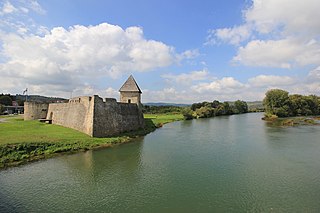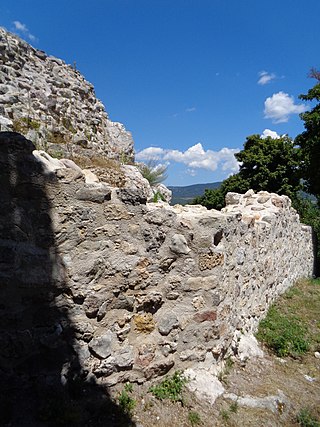
The House of Frankopan was a Croatian noble family, whose members were among the great landowner magnates and high officers of the Kingdom of Croatia in union with Hungary.

Ogulin is a town in north-western Croatia, in Karlovac County. It has a population of 7,389 (2021), and a total municipal population of 12,251 (2021). Ogulin is known for its historic stone castle, known as Kula, and the nearby mountain of Klek.

Crikvenica is a town in Croatia, located on the Adriatic in the Primorje-Gorski Kotar County.

Petar IV Zrinski was Ban of Croatia (Viceroy) from 1665 to 1670, general and a writer. A member of the Zrinski noble family, he was noted for his role in the attempted Croatian-Hungarian Magnate conspiracy to overthrow the Habsburgs, which ultimately led to his execution for high treason.
Stari Grad is a town on the northern side of the island of Hvar in Dalmatia, Croatia. One of the oldest towns in Europe, its position at the end of a long, protected bay and next to prime agricultural land has long made it attractive for human settlement. Stari Grad is also a municipality within the Split-Dalmatia County.

Kraljevica is a town in the Kvarner region of Croatia, located between Rijeka and Crikvenica, approximately thirty kilometers from Opatija and near the entrance to the bridge to the island of Krk. The population of the settlement of Kraljevica itself is 2,857 with a total of 4,618 in the area of the town of Kraljevica, which is part of Primorje-Gorski Kotar County, and includes Šmrika. The town is known for its shipyard which has built a number of ships for the Croatian navy.

Gorski Kotar is the mountainous region in Croatia between Karlovac and Rijeka. Because 63% of its surface is forested it is popularly called the green lungs of Croatia or Croatian Switzerland. The European route E65, which connects Budapest and Zagreb with the Adriatic Port of Rijeka, passes through the region.

Hreljin is a village in western Croatia, just northeast of Bakar and northwest of Kraljevica, above Bay of Bakar.

Trsat is part of the city of Rijeka, Croatia, with a historic castle or fortress in a strategic location and several historic churches, in one of which the Croatian noble Prince Vuk Krsto Frankopan is buried. Trsat is a steep hill, 138 m high, rising over the gorge of the Rječina river, about a kilometre away from the sea; strategically significant from the earliest times right up to the 17th century, it is today a major Christian pilgrimage centre and home to a statue of Pope John Paul II who came to Trsat as a Pilgrim in 2003. Today, the University of Rijeka's newly constructed campus lies in the western part of Trsat.

Novi Vinodolski is a town on the Adriatic Sea coast in Croatia, located south of Crikvenica, Selce and Bribir and north of Senj. The population of Novi is 3,988, with a total of 5,131 people in the city administered area. The city area became a Frankopan property in the 13th century, marking the period to which the most valuable heritage is dated, including the Law codex of Vinodol. City hinterland is dominated by the Vinodol Valley, used for agriculture and winemaking. The city's economy is dominated by tourism, as Novi Vinodolski is well known tourist centre situated in an area largely unaffected by other types of industry and it offers a wide variety of tourist amenities. The Vinodol Valley is also the site of a hydroelectric power plant utilizing water collected in Gorski Kotar reservoirs. Transport links of the city are substantially dependent on the nearby city of Rijeka.

Municipalities in Croatia are the second-lowest administrative unit of government in the country, and along with cities and towns they form the second level of administrative subdisivion, after counties. Each municipality consists of one or more settlements (naselja), which are the third-level spatial units of Croatia.

Drivenik Castle is a castle in the hinterland of Crikvenica and Novi Vinodolski, in the northern part of the Adriatic coast, western Croatia.

Ozalj Castle is a castle in the town of Ozalj, Croatia.

Grižane Castle is a ruined castle and site near Grižane in Vinodol, in the northern part of the Adriatic coast, western Croatia. The castle of Grižane had an odd, rectangular form with circular towers, and this irregularity was caused by the peculiar structure of the field.

Trsat Castle is a castle in Trsat, Croatia. It is thought that the castle lies at the exact spot of an ancient Illyrian and Roman fortress. The Croatian noble Vuk Krsto Frankopan is buried in one of the churches. The Trsat castle was completely reconstructed and renovated in the 19th century when the mausoleum of the military commander Laval Nugent was built in its interior. The courtyard of the castle has now been turned into a restaurant and many tourists visit the place during the summer months.

Tvrdalj Castle is a castle in Stari Grad, on the island of Hvar, Croatia.

Čakovec Castle or Zrinski Castle is a medieval fortification in the middle of the town of Čakovec, the administrative seat of Međimurje County, northern Croatia.

Kostajnica Fortress is a castle in Hrvatska Kostajnica, a town in central Croatia, near the border to Bosnia and Herzegovina.
Bribir is a village in the Primorje-Gorski Kotar County of Croatia. It is located near Crikvenica and Novi Vinodolski, in a valley 5 km from the Adriatic Sea. It has a population of 1,695 and the post code HR-51253. It is the seat of the Vinodol Municipality.

Udbina Castle is a ruined medieval fortified structure in the town of Udbina, Lika-Senj County, Croatia. Built on the top of a hill at the northern end of the town, it overlooks a large part of the Krbava field, just above the place where the fierce and bloody Battle of Krbava between the army of the Kingdom of Croatia and the Ottoman Empire was fought in 1493. Once property of the powerful Kurjaković noble family, the castle was captured by the Ottomans in 1527. It was recaptured in 1689 by Habsburg-Croatian army, but later, by the end of the 19th century, uncared-for, the castle slowly turned into a ruin.




















